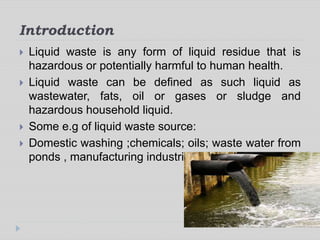Reclaim Waste Things To Know Before You Get This
Reclaim Waste Things To Know Before You Get This
Blog Article
The Best Guide To Reclaim Waste
Table of ContentsAll about Reclaim WasteThe Facts About Reclaim Waste UncoveredExcitement About Reclaim WasteHow Reclaim Waste can Save You Time, Stress, and Money.Reclaim Waste Fundamentals Explained
Check out the kinds, events, and kinds of fluid waste. Domestic sewer waste describes the waste and products from a household septic system. This kind of waste is developed by human beings in residences, institutions, and other structures. This only includes septic containers that have a drain field. The appropriate management and disposal of residential sewage waste call for liquid waste to be moved to a sewage therapy plant where the proper approaches and equipment are related to detoxify and throw away waste.
Business waste frequently consists of potential dangers, such as flammable materials or a combination of liquid and strong waste products, and calls for an advanced and detailed disposal process. The disposal of industrial waste generally includes the purification of waste before transportation to ensure risk-free and correct disposal. Industrial waste is developed from byproducts and runoff of industrial procedures and production.
This type of waste can not use the exact same sewer monitoring transport or procedures as septic or commercial liquids. The hazardous waste monitoring procedure calls for the assessment and screening of fluid waste prior to it undergoes the disposal process (industrial wastewater treatment). Runoff waste is the fluid waste that originates from overflow and excess stormwater in very booming locations or cities
Drainage waste can trigger contamination and flooding if not dealt with effectively. Making sure correct waste monitoring can prevent disasters and reduce ecological injury.
How Reclaim Waste can Save You Time, Stress, and Money.
Get in touch with PROS Services today to discover our waste monitoring and disposal services and the appropriate ways to take care of the fluid waste you produce.
(https://hub.docker.com/u/reclaimwaste1?_gl=1*1980ev1*_ga*MTgwOTc3Nzc2OS4xNzMxMzI1Mzkw*_ga_XJWPQMJYHQ*MTczMTMyNTM5MC4xLjEuMTczMTMyNTcwOC4xMC4wLjA.)This supposed 'wastewater' is not only a vital source however, after therapy, will certainly be launched to our land, waterways or the sea. Used water from commodes, showers, baths, cooking area sinks, laundries and commercial procedures is known as wastewater.

water made use of to cool equipment or clean plant and devices). Stormwater, a form of wastewater, is overflow that flows from agricultural and city areas such as roofs, parks, yards, roadways, paths and seamless gutters into stormwater drains pipes, after rainfall. Stormwater streams without treatment straight to local creeks or rivers, ultimately getting to the ocean.
Things about Reclaim Waste
In Queensland, many wastewater is dealt with at sewer therapy plants. Wastewater is transferred from residential or industrial sites with a system of sewage systems and pump terminals, known as sewage reticulation, to a sewer treatment plant.
The Division of Natural Resources encourages city governments regarding managing, operating and preserving sewerage systems and therapy plants. In unsewered locations, local federal governments may require owners to mount individual or family sewage treatment systems to treat domestic wastewater from toilets, kitchens, shower rooms and washings. The Department of Natural Resources authorises making use of family systems when they are proven to be reliable.
In some brand-new communities, therapy of some stormwater to remove litter, sand and gravel has actually started making use description of gross contaminant catches. Wastewater treatment takes place in four phases: Eliminates strong issue.
Utilizes small living microorganisms understands as micro-organisms to damage down and remove continuing to be dissolved wastes and fine particles. Micro-organisms and wastes are integrated in the sludge.
Not known Incorrect Statements About Reclaim Waste
Nutrient elimination is not available at all sewage treatment plants since it requires costly specialist tools. Clear liquid effluent generated after therapy might still contain disease-causing micro-organisms - liquid waste disposal.

This generally implies wastewater has to be dealt with or contaminants removed before it can be discharged to waterways. The majority of wastewater flows into the sewerage system. Under the Act, regional federal governments carry out approvals and licences for eco appropriate tasks (Periods) including wastewater releases that may have a local influence. The division carries out approvals and licences to ERAs entailing wastewater releases that might have a local or statewide effect.
The 7-Second Trick For Reclaim Waste
Tracking offers accurate details about water high quality and can confirm that licence conditions are being fulfilled. The info acquired through surveillance gives the basis for making water quality choices.
Report this page